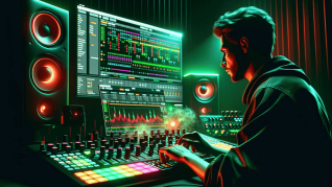
Music has always been a reflection of its time, evolving with cultural shifts, political movements, and, perhaps most significantly, technological advancements. Over the centuries, the intersection of music and technology has shaped the way we create, consume, and experience sound. From rudimentary instruments to the rise of artificial intelligence in music production, here’s an exploration of how technology has revolutionized the music landscape.
The Early Days: Acoustic Beginnings
For thousands of years, music was purely acoustic. Early humans created rudimentary instruments like drums, flutes, and stringed instruments from natural materials. As civilizations advanced, so did the sophistication of instruments. The piano, violin, and organ emerged in the Middle Ages and the Renaissance, pushing the boundaries of composition and performance. However, the creation and performance of music were confined to physical spaces—concert halls, churches, and salons.
The Industrial Revolution: Mechanization Meets Music
The 19th century brought significant innovations in both music and its dissemination. The invention of the phonograph by Thomas Edison in 1877 marked a seismic shift, allowing sound to be recorded and played back for the first time. This was a turning point, as music could now be experienced without live performance. Records and, later, gramophones made music accessible to broader audiences, laying the groundwork for a new era of music consumption.
At the same time, player pianos and mechanical music devices automated performance, allowing even non-musicians to experience sophisticated compositions at home. These advancements democratized music consumption, moving it from concert halls to living rooms.
The Electric Era: Amplification and New Instruments
The 20th century saw the dawn of the electric era in music. The electric guitar, invented in the 1930s, changed the landscape of popular music. Rock and roll, blues, and jazz thrived on the electrified sound that allowed musicians to experiment with volume and distortion, leading to new genres.
Meanwhile, radio and television broadcasting further expanded music’s reach, enabling artists to gain nationwide, even global, fame. For the first time, live performances were accessible to those far away from concert venues.
The Digital Revolution: Music Goes Global
Rauf Hameed says with the introduction of digital recording and production in the late 20th century, the music industry experienced one of its most transformative periods. Compact discs (CDs) replaced vinyl records and cassette tapes, offering higher-quality sound and greater portability. But this was just the beginning.
The rise of personal computers in the 1980s and 1990s gave birth to digital audio workstations (DAWs), such as Pro Tools, Cubase, and Ableton Live. These software platforms allowed musicians and producers to compose, record, and mix music with unprecedented precision and creativity. Artists could now produce entire albums in home studios without the need for expensive recording spaces.
MIDI (Musical Instrument Digital Interface), a technology that allowed electronic instruments and computers to communicate, revolutionized how music was composed. Synthesizers, drum machines, and sequencers became mainstays of genres like electronic dance music (EDM) and hip-hop, fundamentally reshaping the sonic landscape.
The Internet Age: Streaming and Democratization
As the internet grew in the late 1990s and early 2000s, it fundamentally altered how we discover and consume music. Peer-to-peer file-sharing services like Napster and LimeWire disrupted the traditional music business model, leading to a decline in physical album sales and forcing the industry to adapt.
The rise of streaming platforms like Spotify, Apple Music, and YouTube solidified the internet’s role in the music ecosystem. Now, anyone with a smartphone or computer could access millions of songs at the tap of a screen. This democratization of music consumption allowed independent artists to distribute their work without needing a major record label, leading to a more diverse and vibrant music scene.
Artificial Intelligence and the Future of Music
Today, we are at the cusp of a new era where artificial intelligence (AI) is playing an increasingly important role in music creation and curation. AI-driven platforms like OpenAI’s MuseNet and AIVA (Artificial Intelligence Virtual Artist) can generate original compositions, while AI algorithms on streaming platforms curate personalized playlists based on listening habits.
Additionally, blockchain technology and NFTs (non-fungible tokens) are offering new ways for artists to monetize their work and connect directly with fans, bypassing traditional record labels and distribution platforms.
The Harmonious Dance of Music and Technology
The evolution of music and technology is a symphony of innovation and creativity. From the earliest acoustic instruments to AI-generated compositions, technological advancements have continuously reshaped how we experience music. In the past century alone, music has evolved from being an ephemeral art form, limited to live performances, to a ubiquitous, global experience available to anyone with an internet connection.
As technology continues to advance, the future of music promises even more exciting possibilities—collaborations between human artists and machines, immersive experiences in virtual reality, and perhaps even new genres that we cannot yet imagine. The only certainty is that music, like technology, will continue to evolve, inspiring and connecting people around the world.
